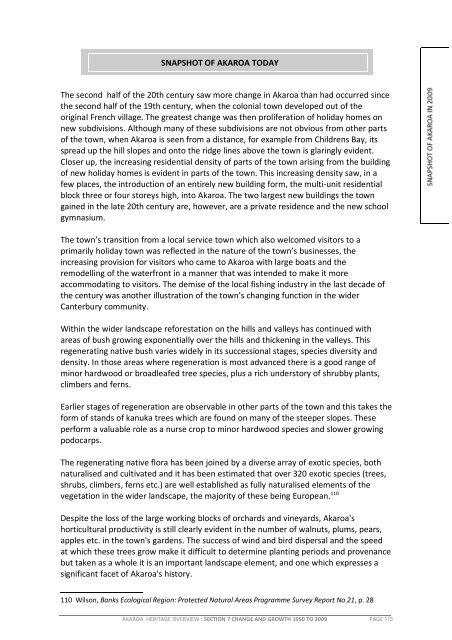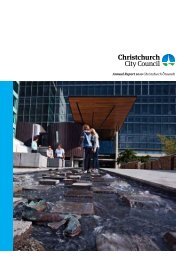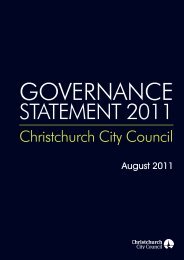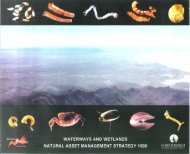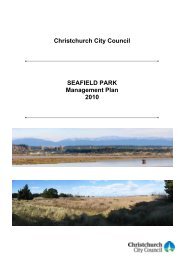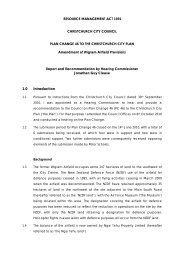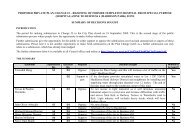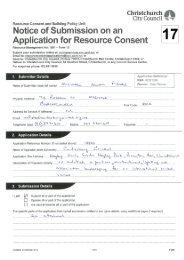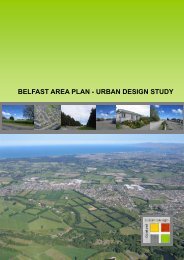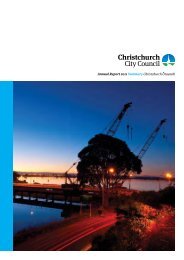Akaroa Historical Overview - Christchurch City Council
Akaroa Historical Overview - Christchurch City Council
Akaroa Historical Overview - Christchurch City Council
You also want an ePaper? Increase the reach of your titles
YUMPU automatically turns print PDFs into web optimized ePapers that Google loves.
c<br />
SNAPSHOT OF AKAROA TODAY<br />
The second half of the 20th century saw more change in <strong>Akaroa</strong> than had occurred since<br />
the second half of the 19th century, when the colonial town developed out of the<br />
original French village. The greatest change was then proliferation of holiday homes on<br />
new subdivisions. Although many of these subdivisions are not obvious from other parts<br />
of the town, when <strong>Akaroa</strong> is seen from a distance, for example from Childrens Bay, its<br />
spread up the hill slopes and onto the ridge lines above the town is glaringly evident.<br />
Closer up, the increasing residential density of parts of the town arising from the building<br />
of new holiday homes is evident in parts of the town. This increasing density saw, in a<br />
few places, the introduction of an entirely new building form, the multi-unit residential<br />
block three or four storeys high, into <strong>Akaroa</strong>. The two largest new buildings the town<br />
gained in the late 20th century are, however, are a private residence and the new school<br />
gymnasium.<br />
The town’s transition from a local service town which also welcomed visitors to a<br />
primarily holiday town was reflected in the nature of the town’s businesses, the<br />
increasing provision for visitors who came to <strong>Akaroa</strong> with large boats and the<br />
remodelling of the waterfront in a manner that was intended to make it more<br />
accommodating to visitors. The demise of the local fishing industry in the last decade of<br />
the century was another illustration of the town’s changing function in the wider<br />
Canterbury community.<br />
Within the wider landscape reforestation on the hills and valleys has continued with<br />
areas of bush growing exponentially over the hills and thickening in the valleys. This<br />
regenerating native bush varies widely in its successional stages, species diversity and<br />
density. In those areas where regeneration is most advanced there is a good range of<br />
minor hardwood or broadleafed tree species, plus a rich understory of shrubby plants,<br />
climbers and ferns.<br />
Earlier stages of regeneration are observable in other parts of the town and this takes the<br />
form of stands of kanuka trees which are found on many of the steeper slopes. These<br />
perform a valuable role as a nurse crop to minor hardwood species and slower growing<br />
podocarps.<br />
The regenerating native flora has been joined by a diverse array of exotic species, both<br />
naturalised and cultivated and it has been estimated that over 320 exotic species (trees,<br />
shrubs, climbers, ferns etc.) are well established as fully naturalised elements of the<br />
vegetation in the wider landscape, the majority of these being European. 110<br />
Despite the loss of the large working blocks of orchards and vineyards, <strong>Akaroa</strong>'s<br />
horticultural productivity is still clearly evident in the number of walnuts, plums, pears,<br />
apples etc. in the town's gardens. The success of wind and bird dispersal and the speed<br />
at which these trees grow make it difficult to determine planting periods and provenance<br />
but taken as a whole it is an important landscape element, and one which expresses a<br />
significant facet of <strong>Akaroa</strong>'s history.<br />
110 Wilson, Banks Ecological Region: Protected Natural Areas Programme Survey Report No 21, p. 28<br />
AKAROA HERITAGE OVERVIEW : SECTION 7 CHANGE AND GROWTH 1950 TO 2009 PAGE 173


